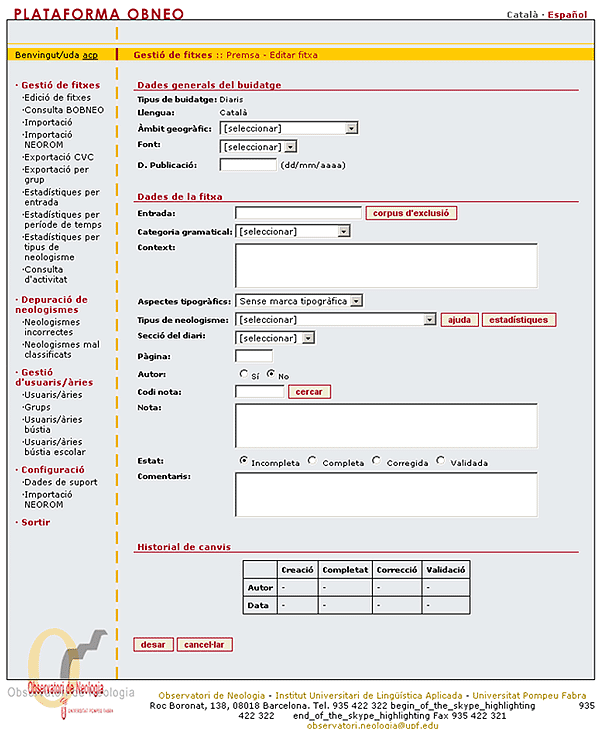Fitxa buidatge

The basic record used in the Observatori de Neologia contains the following fields:
- General information: it includes the type of extraction (press, oral texts, magazines), language (Catalan or Spanish), geographic zone, source and date of publication.
- Record information
- Entry: the neologism, in its lemma form, as documented in the source.
- Part of speech: indication of part of speech according to documented usage.
- Context: transcription of the context in which the neologism is documented; asterisks are used to highlight the new word.
- Typographical information: indication of typographical information that may be signalling the neologism as such in the source, e.g. italics, bold, quotation marks, etc.
- Type of neologism: indication of the procedure involved in the creation of the neologism; the typology in use includes formal processes (suffixation, prefixation, compounding, classical or learned compounding, etc.), semantic processes, syntactic processes and loans.
- Section: specific section in the newspaper or magazine where the neologism is found.
- Page: page of the source where the neologism is found. For Internet sources there is no need to indicate page number.
- Note code and Notes: this field is used to record any additional information, such as the fact that the neologism is a variant of a word already documented in reference dictionaries, etc. The appropriate code for this information is also shown.
- State: phase of elaboration.
- Comments: space where the neologer can add comments for the supervisor.
- History of changes
- Creator: indication that the new word is considered as having been coined by that person.
- Date: day of the state modification.
The record used to collect information from the press is the same as the basic record; records used to collect data from oral texts and magazines add specific information fields according to the nature of the source.
Oral texts
- Phonetic transcription: phonetic transcription of the neologism, in its lemma form, which is compulsory for some types of neologism (compunds and loans).
- Metalinguistic information: this field is used to record any additional information, explicit or implicit, which shows some metalinguistic information about the neologism.
- Date: day of the program broadcast.
- Minute
- Radio Station
- Section: only recorded in the news.
- Title: source in which the neologism is recorded.
- Speaker's role: speaker's role during the program, such as presenter, reporter...
- Speaker's age: this field is used to record the speaker's age.
- Speaker's gender: this field is used to record the speaker's gender.
- Speaker's dialect: this field is used to record the speaker's dialect.
- Speaker's mother tongue: this field is used to record the speaker's mother tongue only if he or she is not Catalan.
Spontaneous texts
- Textual area: different kinds of areas where the neologism is documented, such as computing, sports, culture...
- Frequency: this field is used to record the frequency of the source.
- Proofreading level: this field shows the condition of the text according to linguistic treatment, typographical errors...
- Explicit proofreading: indication that the source is considered as having been proofreaded.
- Systematic spontaneous text: indication that the spontaneous text is systematic.
